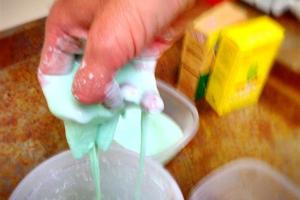Creative Alternatives: How to Make Oobleck Without Cornstarch

-
Quick Links:
- Introduction
- What is Oobleck?
- Why Make Oobleck Without Cornstarch?
- Alternatives to Cornstarch
- Step-by-Step Guide to Making Oobleck Without Cornstarch
- Case Studies and Examples
- Expert Insights
- Conclusion
- FAQs
Introduction
Oobleck is a fascinating non-Newtonian fluid that behaves like a solid when pressure is applied but flows like a liquid when left undisturbed. Traditionally made with cornstarch and water, many individuals seek alternatives due to dietary restrictions or lack of availability. In this article, we will explore how to create oobleck without cornstarch, providing you with simple, accessible recipes and insights on this engaging science experiment.What is Oobleck?
Oobleck is named after a substance in Dr. Seuss's book "Bartholomew and the Oobleck." It is a playful mixture that serves not only as a fun activity for children but also as an educational tool to illustrate concepts such as viscosity, states of matter, and non-Newtonian fluid dynamics.Why Make Oobleck Without Cornstarch?
There are several reasons why one might want to create oobleck without cornstarch: - **Dietary Restrictions:** Individuals with corn allergies or those following specific diets may need alternatives. - **Availability:** Cornstarch may not always be available in your pantry. - **Experimentation:** Trying different ingredients can lead to new textures and properties, enriching the learning experience.Alternatives to Cornstarch
If you want to make oobleck without cornstarch, consider these alternatives: - **Tapioca Starch:** A common substitute that provides a similar consistency. - **Potato Starch:** Another excellent thickening agent that can create a comparable non-Newtonian fluid. - **Flour:** While it changes the texture significantly, it can be used in a pinch. - **Psyllium Husk Powder:** A health supplement that can thicken liquids effectively. - **Xanthan Gum:** Used in gluten-free cooking, xanthan gum is a powerful thickener.Step-by-Step Guide to Making Oobleck Without Cornstarch
Using Tapioca Starch
- Ingredients:
- 1 cup tapioca starch
- 1/2 cup water
- Instructions:
- In a bowl, gradually add water to the tapioca starch.
- Mix thoroughly until a smooth consistency is achieved.
- Adjust the texture by adding more starch or water as needed.
Using Potato Starch
- Ingredients:
- 1 cup potato starch
- 1/2 cup water
- Instructions:
- Combine potato starch and water in a mixing bowl.
- Stir until the mixture is smooth and consistent.
- Test the fluid by applying pressure; adjust the amounts if necessary.
Using Flour
- Ingredients:
- 1 cup all-purpose flour
- 1/2 cup water
- Instructions:
- Mix flour and water in a bowl, stirring continuously.
- Look for a gooey consistency; you may need to adjust water levels.
- This version may not have the same properties as traditional oobleck but is still fun to play with.
Case Studies and Examples
Numerous educators and parents have conducted experiments using various alternatives to cornstarch. For instance, a kindergarten class in Seattle used tapioca starch for their oobleck-making session. They observed that it produced a fluid that was just as enjoyable to play with, demonstrating the adaptability of oobleck recipes.Expert Insights
Educational experts emphasize the value of using non-Newtonian fluids in teaching science concepts. According to Dr. Emily Watson, a physicist at the University of Science, “Creating substances like oobleck helps children understand the principles of viscosity and the behavior of materials under different conditions.”Conclusion
Making oobleck without cornstarch opens up a world of possibilities for creativity and education. By utilizing readily available alternatives like tapioca and potato starch, you can enjoy the fun and educational benefits of oobleck while accommodating dietary needs or ingredient availability.FAQs
1. Can I use other types of starches to make oobleck?
Yes, alternatives like tapioca starch and potato starch work well for creating oobleck.
2. How long does homemade oobleck last?
Oobleck can last for several days when stored in an airtight container in the refrigerator, but it’s best used fresh.
3. Is oobleck safe for kids?
Yes, oobleck is generally safe for children, but supervision is advised to prevent ingestion of large amounts.
4. Can I add food coloring to oobleck?
Absolutely! Food coloring can be added to make the oobleck more visually appealing.
5. What can I do with leftover oobleck?
Leftover oobleck can be disposed of in the trash, as it can clog drains.
6. How do I clean up oobleck spills?
Let it dry and then scrape it up. For fresh spills, using water helps to dissolve it.
7. Is oobleck biodegradable?
Yes, oobleck made from natural ingredients is biodegradable and safe for the environment.
8. Can I use oobleck for art projects?
While not traditional, you can use oobleck in art projects to explore textures and colors.
9. What happens when you heat oobleck?
Heating oobleck changes its properties, making it more liquid-like and less viscous.
10. Is there a difference in texture between cornstarch oobleck and alternatives?
Yes, different starches can yield variations in texture and consistency, allowing for unique experiences.
Random Reads
- The ultimate guide to syncing fitbit iphone
- How to make a viral video
- How to play minecraft pe multiplayer
- How to make a powerpoint template
- Mastering sound recording audio from sound card
- Mastering ssh
- Safely get rid of empty paint cans
- Safely clean laptop screen household products
- How to mirror your macs screen to apple tv
- How to raise a dorm bed